by Marley Heltai // Apr. 19, 2024
At this year’s Venice Biennale, an impressive collateral exhibition—curated by Björn Geldhof, Ksenia Malykh and Oleksandra Pogrebnyak—invites visitors to explore Ukrainian history and culture, with a view to amplifying subdued voices worldwide, offering songs of resistance and resilience. For nearly two decades, the PinchukArtCentre has stood as a cultural beacon within Ukraine’s art scene, fostering emerging talents and championing the nation’s artistic heritage. With the outbreak of the war, the institution underwent a significant transformation, evolving from a platform for artistic discovery to a staunch international advocate of Ukrainian art. Speaking with Geldhof, the artistic director of the PinchukArtCentre in Kyiv, we gained insights into the process that the center went through, in order to take up the more activist role it proudly assumes now.
Through the work of 22 different artists and collectives, ‘From Ukraine: Dare to Dream’ bridges narratives of struggle with visions of hope and resistance. The exhibition features both Ukrainian and non-Ukrainian artists, offering diverse perspectives on resilience, environmental stewardship and personal visions of utopia. We discussed the importance of a research-based approach to preserving the rich culture of Ukraine, the profound shift the Ukrainian art scene has undergone in the past few years and the importance of interacting with other voices and artists worldwide in a spirit of solidarity. Ahead of the exhibition’s opening, Geldhof offered descriptions of many of the exhibition’s site-specific installations, as well as glimpses of hope and possibility in tumultuous times.
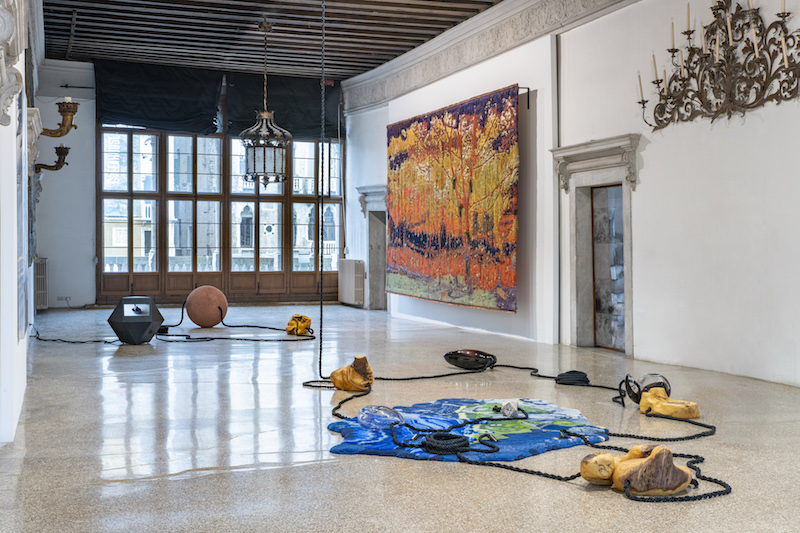
Otobong Nkanga: ‘Lined with shivers sprouting from the rock,’ 2021, wool carpet, cotton hand-knotted ropes, weeping beech wood, sculptures, hand-blown glass sculptures, clay sculptures, metal, video, organic materials and various oils // Courtesy of the artist and Castello di Rivoli Museo d’Arte Contemporanea
Marley Heltai: For nearly two decades, the PinchukArtCentre has played a significant role in Ukraine’s art scene. How has its mission evolved or shifted in response to the full-scale invasion of Ukraine in recent years?
Björn Geldhof: When the PinchukArtCentre started, it was a place where we brought in specifically the young generation to discover voices and ways of thinking that were simply not known in Ukraine. That’s kind of where it started; bringing in new ideas and, through these ideas, giving different ways of dreaming and seeing the future and seeing one’s own life. In 2009, the art center underwent the first change because then the prizes started; the PinchukArtCentre Prize, which is focused on emerging Ukrainian artists, and then later the Future Generation Art Prize. They really kind of dramatically made an impact on what the institution was doing, because suddenly, you move away from blue chip art and you move towards what is going on with many of the younger artists who are creating new ideas and different ways of thinking that aren’t yet established.
Then, from 2015, we took another step where we decided to delve much deeper into Ukrainian art from a research-based perspective. We started a research platform that built the first archive on Ukrainian art, which is an extensive online tool that basically maps Ukrainian art from the 1960s until today, something that didn’t exist prior. So over this short time of one decade, the art center really dramatically shifted into another direction where we focused on two main pillars: emerging artists and research and development of Ukrainian art.
And then the full-scale invasion happened, so we closed the museum because Kyiv was under threat. The first thing was to get people out and then to get artworks out, in that order. And once Kyiv was liberated, or rather just in that moment between the liberation and the near occupation, we took on a very different role. Our role was focused on speaking about Ukraine as loudly as possible. Putin was saying that Ukraine is not a country and that Ukraine has no culture, but fortunately we had all the proof to say otherwise.
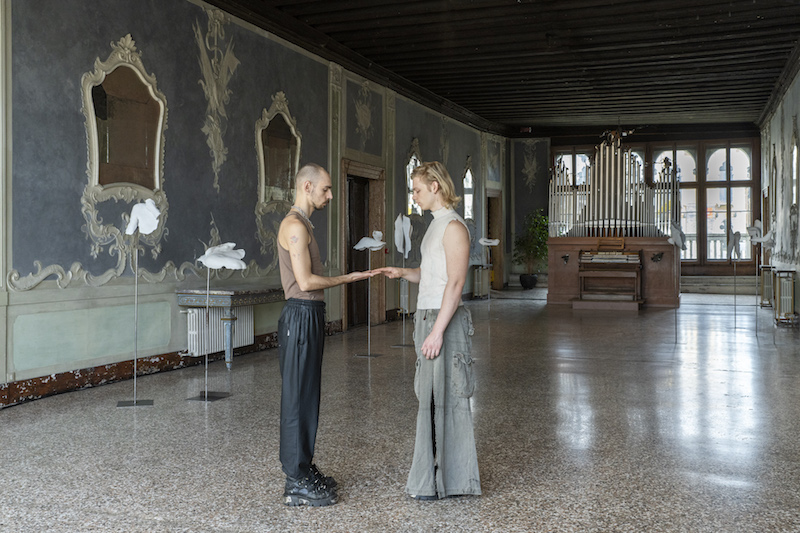
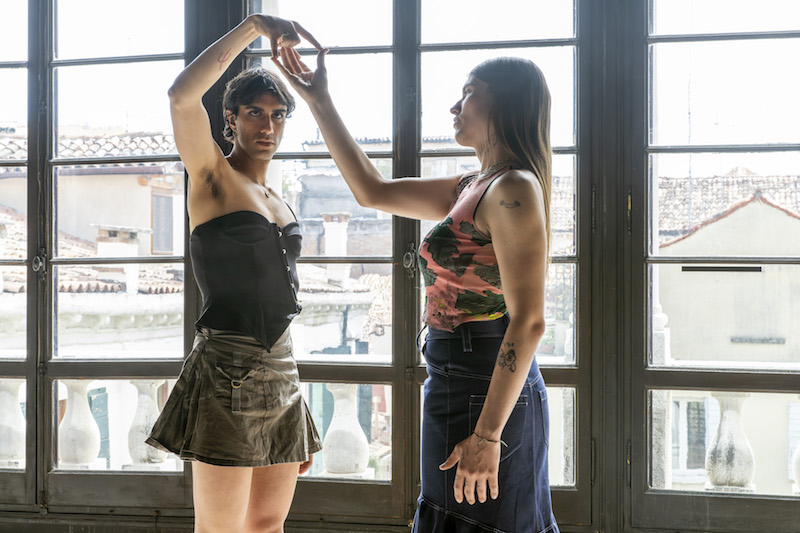
Alex Baczynski-Jenkins: ‘Federico,’ 2015, choreography, 8’, performed by Bassem Saad and Nomi Sladko, Boji Moroz and Sasha Malyuk, originally developed with: Jayson Patterson and Nicholas Finegan, commissioned by Montague Space, London, with thanks to Tim Steer // Courtesy of the artist
MH: What did that look like in practice?
BG: We made a lot of exhibitions internationally. My team and I shifted our focus from being institutional to activist. What the institution did for the better part of the first year of the war was really, in an activist way, operate on the international scene, where you go with as many projects as possible to speak as loudly as possible about Ukraine, its culture.
We were able to reopen the museum in June 2022, about two months after the liberation of Kyiv. When we reopened the museum, we understood very quickly that by opening the museum, we gave a possibility for our audiences to sort of breathe in a different way than they would normally. I mean, not physically breathe, but mentally, creatively, psychologically breathe. Gradually, we got to a situation where we had pre-war numbers in the museum, but with a very different audience. What we’ve discovered is that our audience changed from the people who we normally served to completely new people, who never went to museums before and who come there now to engage because they find things they need.
We have the ability to speak of the war in a very indirect way, or to explore tangible subjects that are important for them. That gave us a completely different raison d’être, where we have to be conscious about the audience and where we have to engage differently with them. But still, what we also discovered is that art, or rather the cultural experience, has become really essential for many Ukrainians today.
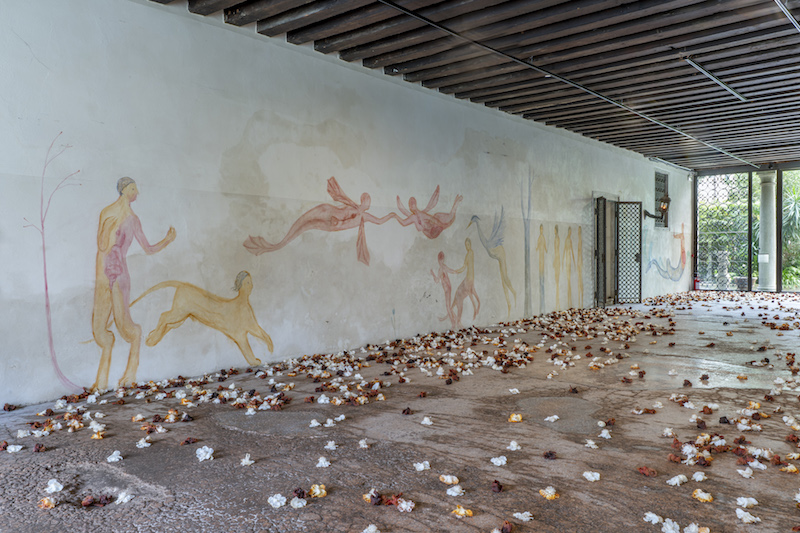
Kateryna Lysovenko: ‘Rewriting the Bible from the Propaganda of the World of My Dreams,’ series, 2024, acrylic // Courtesy of the artist, produced with the support of PinchukArtCentre
MH: You spoke a lot about the protection and promotion of Ukrainian culture and art. On that note, including non-Ukrainian artists in the exhibition in Venice is an interesting choice. Could you elaborate a bit on why these artists were chosen and how their work contributes to the overall narrative of ‘From Ukraine: Dare to Dream’?
BG: I think when we speak about the exhibition in Venice, we have to understand that Ukraine has this very unique platform. There’s no other war in the world that has received two years of nonstop attention and incredible support from the West. But with that, I believe there is also a sort of unique responsibility to connect back to what is happening in the rest of the world, to conflicts that might not be thought of or might not receive the support and the attention that they deserve or subject matter that might not receive that. Ukraine is not alone in suffering. Are we able to address the other places and subjects suffering when we’re kind of completely submerged in this war? And while others are completely submerged in conflicts or challenges of their own, we can still dream and ask ourselves, can we still do this? Do we have this possibility?
With this exhibition, that’s what we want to do. It’s not an escapist show. We are very aware of all challenges, and they’re very strongly present in the exhibition. But, at the same time, the exhibition tries to break that, from time to time, by allowing us to look beyond it, to try to imagine something different.
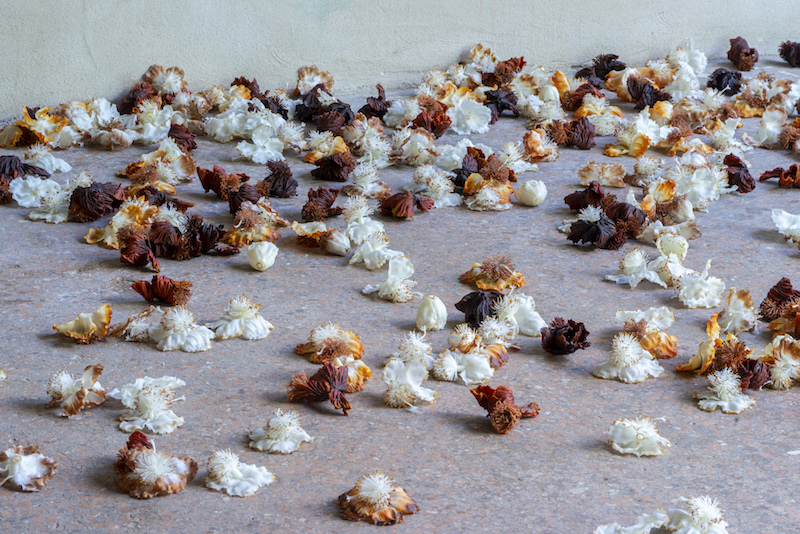
Allora & Calzadilla: ‘Graft,’ 2024, recycled polyvinyl chloride and paint // Courtesy of the artists and kurimanzutto, Mexico City/New York, co-produced with the support of PinchukArtCentre
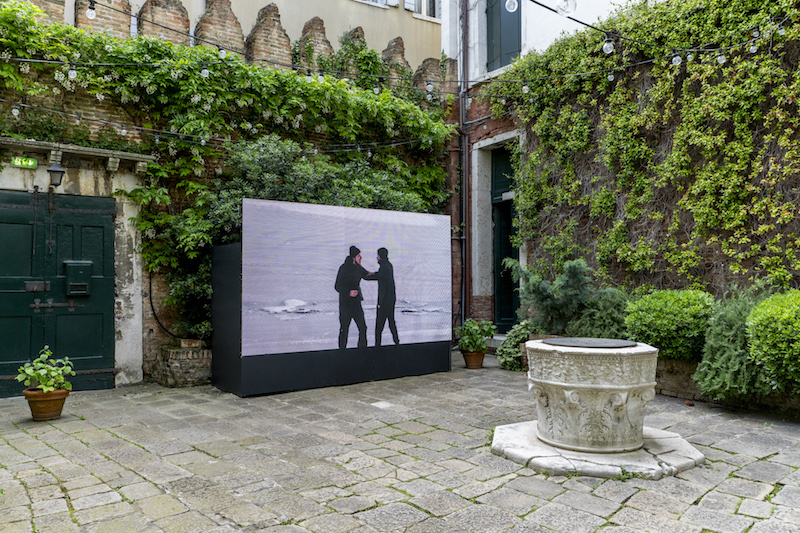
Daniil Revkovskiy and Andriy Rachinskiy: ‘Clanking, Hammering, Dispute and Gurgling,’ 2020, video, 9’27’’ // Courtesy of the artists, produced with the support of PinchukArtCentre
MH: The exhibition aims to address Earth’s ecological disasters and envision a new utopia. Could you provide some examples of how these themes will be manifested in the exhibition’s installations and displays?
BG: There’s two entry points with the exhibition: one of them features the work of Allora & Calzadilla, and their painted baobab flowers. Baobabs are one of the oldest trees in the world and they’re dying massively because of climate change. So the artists took that flower, and they started hand painting it on a sort of plastic material, but they look absolutely real and are portrayed in different stages of decay. It starts in a way with this feeling of the flowers, which, on one hand, is beautiful and very touching, almost romantic. But, on the other hand, they’re plastic and they’re speaking on the subject of how climate change and human action are destroying, in a broader sense, the Earth around us. In conversation with that, there will be a large-scale fresco by Kateryna Lysovenko. She’s actually painting today and exploring the potential new utopia we can think about. How do we look at this garden of Eden that has been promised to us? And how would we translate that garden of Eden today?
Outside will be a film by two Ukrainian artists, Daniil Revkovskiy and Andriy Rachinskiy, which is a movie that they made on a landscape of sublime horror, in Ukraine in the Dnipropetrovsk region. There, one can see the remnants of iron ore. When they break iron ore, there’s a material that is slightly radioactive that comes free, which is black, almost like an obsidian. Historically, in the Soviet Union, where land was never a problem, they just put that outside. So you have these kind of incredible fields of black poisonous material that are always, you know, made wet, because it doesn’t go into the air, but into the soil. It’s a kind of heritage from the Soviet Union that cannot be easily cleaned up.
On one hand, it resonates very strongly with the Allora & Calzadilla piece. And, in an opposite way, it resonates with the kind of future thinking of Lysovenko, because their idea of the future is quite different from one another. And then, inside of that, you hear the voices of a work by Shilpa Gupta, in which she created moving microphones that are singing collective songs of resistance and resilience from different places in the world, of people finding words to resist power structures. [It addresses] climate change and the way we deal with nature, together with our future visions and the need that we all have to resist, to survive, to continue.
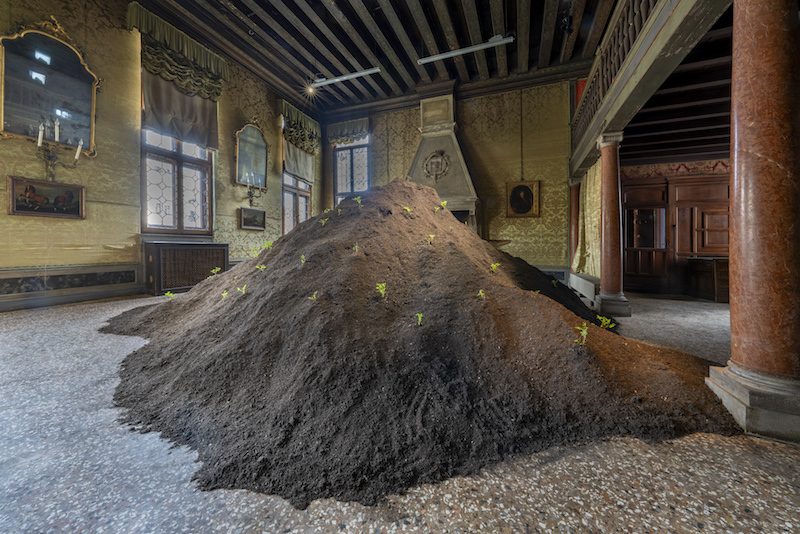
Fatma Bucak: ‘Damascus Rose,’ 2016–ongoing, Damask rose cuttings from Damascus grafted into rose plants of the country, variable dimensions // Courtesy of the artist, co-produced with the support of PinchukArtCentre
and Simodi Gallery
MH: In line with the theme of the Ukrainian Pavilion exhibition that you curated in 2015, titled ‘Hope,’ this exhibition wants to highlight “hopes grown within the shadows of global conflicts.” How can we expect to encounter this in the exhibition?
BG: There’s several works that speak to that but I’ll just mention one, as it’s particularly beautiful. It’s a work by Turkish-Kurdish artist Fatma Bucak. She brings Damascus roses to Venice. The Damascus rose only grows in Syria and you cannot transport roses, as it’s forbidden by law, meaning these roses traveled illegally to Venice. And now, here they are, growing again (or not). We are planting them right now and they are a living representation of all of us being uprooted and finding roots elsewhere; making new life, creating new life. It’s this idea that sometimes (forced) migration is very hard. That is one of these subjects that divides the world in many different ways. And yet, from that, you can find hope, because if you take root, something new and beautiful can enter and take form.
Exhibition Info
PinchukArtCentre
Group Show: ‘From Ukraine: Dare to Dream’
Exhibition: Apr. 20–Aug. 1, 2024
pinchukartcentre.org
Palazzo Contarini Polignac, Sestiere Dorsoduro, 874, 30123, Venice, click here for map



















